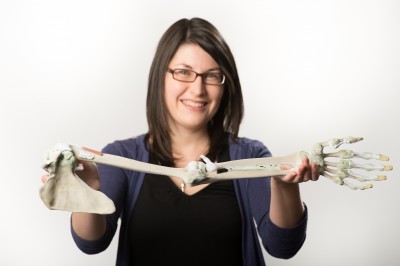3D-printed-anatomy developers aim to revolutionize medical education
July 22, 2014

Part of the 3D Printed Anatomy Series (credit: Monash University)
A kit of 3D-printed anatomical body parts could revolutionize medical education and training, according to its developers at Monash University.
Professor Paul McMenamin, Director of the University’s Centre for Human Anatomy Education, said the simple and cost-effective anatomical kit would dramatically improve trainee doctors’ and other health professionals’ knowledge and could even contribute to the development of new surgical treatments.
“Many medical schools report either a shortage of cadavers, or find their handling and storage too expensive as a result of strict regulations governing where cadavers can be dissected,” he said.
“Without the ability to look inside the body and see the muscles, tendons, ligaments, and blood vessels, it’s incredibly hard for students to understand human anatomy. We believe our version, which looks just like the real thing, will make a huge difference.”
The 3D Printed Anatomy Series kit, to go on sale later this year, could have particular impact in developing countries where cadavers aren’t readily available, or are prohibited for cultural or religious reasons.
After scanning real anatomical specimens with either a CT or surface laser scanner, the body parts are 3D printed either in a plaster-like powder or in plastic, resulting in high resolution, accurate color reproductions.
Further details have been published online in the journal Anatomical Sciences Education.
Abstract of Anatomical Sciences Education paper
The teaching of anatomy has consistently been the subject of societal controversy, especially in the context of employing cadaveric materials in professional medical and allied health professional training. The reduction in dissection-based teaching in medical and allied health professional training programs has been in part due to the financial considerations involved in maintaining bequest programs, accessing human cadavers and concerns with health and safety considerations for students and staff exposed to formalin-containing embalming fluids. This report details how additive manufacturing or three-dimensional (3D) printing allows the creation of reproductions of prosected human cadaver and other anatomical specimens that obviates many of the above issues. These 3D prints are high resolution, accurate color reproductions of prosections based on data acquired by surface scanning or CT imaging. The application of 3D printing to produce models of negative spaces, contrast CT radiographic data using segmentation software is illustrated. The accuracy of printed specimens is compared with original specimens. This alternative approach to producing anatomically accurate reproductions offers many advantages over plastination as it allows rapid production of multiple copies of any dissected specimen, at any size scale and should be suitable for any teaching facility in any country, thereby avoiding some of the cultural and ethical issues associated with cadaver specimens either in an embalmed or plastinated form. Anat Sci Educ. © 2014 American Association of Anatomists.